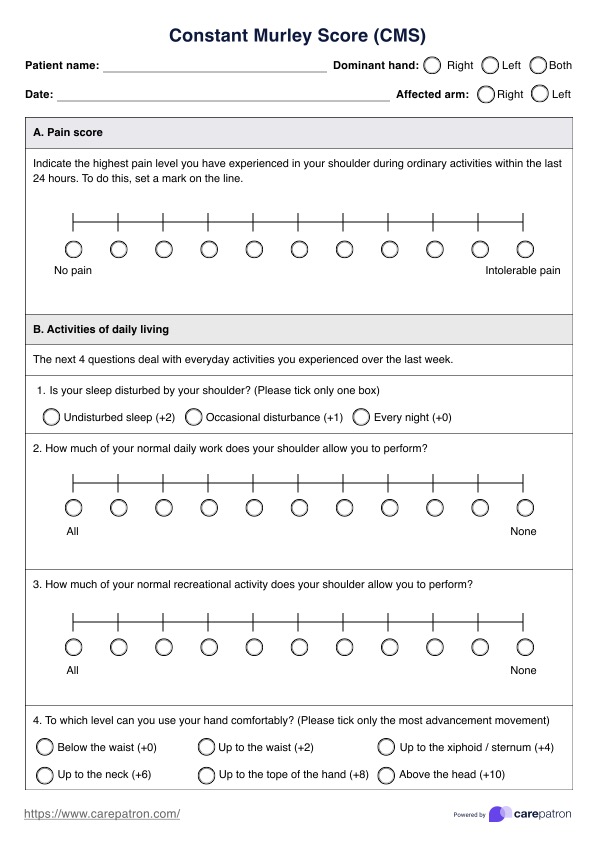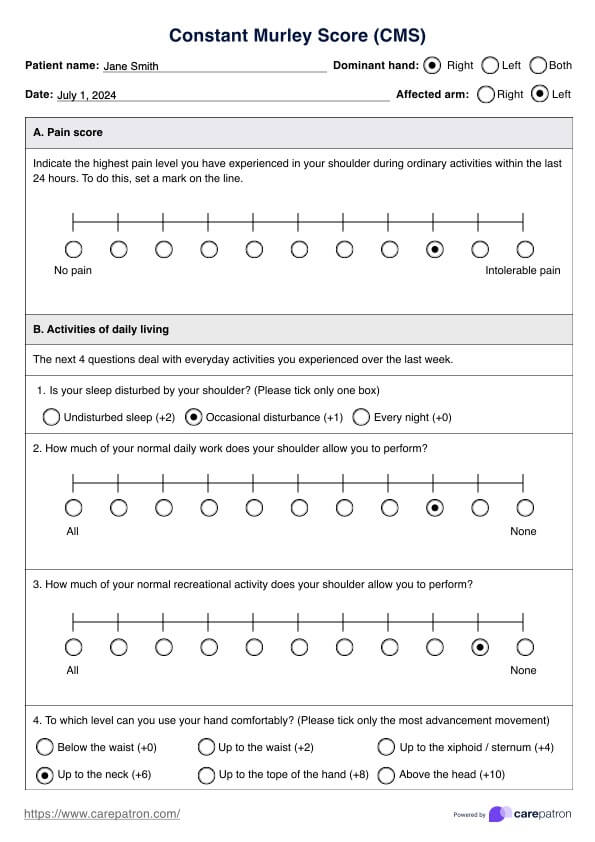Constant Murley Score (CMS)
Evaluate shoulder functionality with the Constant Murley Score (CMS). Learn how to score pain, daily activities, range of motion, and strength. Enhance treatment planning today!


What is the Constant Murley Score (CMS)?
The Constant Murley Score (CMS) is a clinical tool used to evaluate the shoulder's functionality, specifically assessing pain, the ability to perform daily activities, range of motion, and strength. It is widely used by healthcare professionals to gauge the severity of shoulder conditions and monitor treatment progress over time.
How is it scored?
The CMS is scored out of a total of 100 points, divided into four main components:
- Pain (15 points): This section evaluates the intensity and frequency of pain experienced by the patient. The constant score is based on the patient's self-reported pain level, ranging from no pain (15 points) to severe pain (0 points).
- Activities of daily living (20 points): This component assesses the patient's ability to perform common daily activities such as personal hygiene, dressing, and work-related tasks. The score is assigned based on the patient's capability to carry out these activities independently or with difficulty.
- Range of motion (40 points): This section measures the shoulder's range of motion in different directions, including flexion, abduction, internal rotation, and external rotation. Each movement is scored individually, and the total score is the sum of these measurements, reflecting the overall flexibility and mobility of the shoulder joint.
- Strength (25 points): This component evaluates the strength of the shoulder muscles, typically measured using a spring balance or similar device. The score is determined by the maximum weight the patient can hold with the arm in 90 degrees of abduction.
Next steps after using this score
After calculating the CMS, healthcare providers can determine the severity of the shoulder condition and formulate a treatment plan. A higher score indicates better shoulder function, while a lower score suggests more significant impairment. Based on the score, a treatment strategy may include physical therapy, medication, or, in some cases, surgery. Regular re-assessment using the CMS can help track the effectiveness of the treatment and make necessary adjustments.
Constant Murley Score Template
Constant Murley Score Example
How to use our CMS template
Using our CMS template is straightforward and efficient, designed to streamline the assessment of shoulder function. Follow these steps to ensure accurate scoring and evaluation of this simple shoulder test:
Step 1: Download the template
Access our CMS template from our website. You can also find it in the Carepatron app.
Step 2: Give your patient a copy
This CMS template includes a patient portion and a physician portion for subjective and objective measurements. Ask your patient to fill out the patient portion on their own This will save time and allow for a more efficient evaluation during your session.
Step 3: Perform the tests included in the template
Once your patient has filled out their portion of the template, you can use it to assess their shoulder function. Perform the tests in the template to evaluate active range of motion, posture, and pain levels in patients with shoulder injuries or conditions.
Step 4: Score and document your findings
Using our CMS template makes scoring the tests quick and easy. Simply follow the instructions included in the template to score each component of CMS template.
Benefits of using this score
The Constant Murley Score offers numerous benefits for healthcare professionals and patients. As a standardized and comprehensive tool, it provides a reliable method for evaluating shoulder function and ensures consistent assessments of adult shoulder function across different practitioners and settings.
- Comprehensive evaluation: The CMS assesses multiple aspects of shoulder function, including pain, daily activities, range of motion, and strength.
- Objective measurements: The CMS minimizes evaluation subjectivity by providing clear criteria and scoring guidelines. This objectivity ensures that assessments are accurate and comparable over time and between different evaluators.
- Tracking progress: Regular use of the CMS allows healthcare providers to monitor changes in shoulder function over time. This is particularly useful for assessing the effectiveness of treatments and making necessary adjustments to optimize patient outcomes.
- Treatment planning: The detailed information gathered through the CMS helps clinicians develop targeted treatment plans. By identifying specific areas of impairment, providers can tailor interventions to address the patient's unique needs.
- Enhanced communication: The CMS's standardized nature facilitates clear communication between healthcare providers, patients, and other stakeholders.
Overall, the Constant Murley Score is an invaluable tool for enhancing the quality of shoulder care, leading to better patient outcomes and more effective treatments.
Commonly asked questions
The Constant Murley Score (CMS) is a clinical tool used to evaluate shoulder function and assess for shoulder pain, daily activities, range of motion, and strength.
The Constant Murley shoulder assessment score is out of 100 points, with 15 points for pain, 20 for daily activities, 40 for range of motion, and 25 for strength.
The Constant Murley Score (CMS) provides a comprehensive and standardized method for assessing shoulder function and shoulder instability, aiding in diagnosis, treatment planning, and tracking progress over time.







































































































